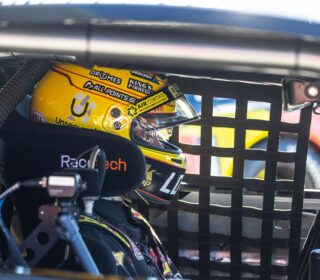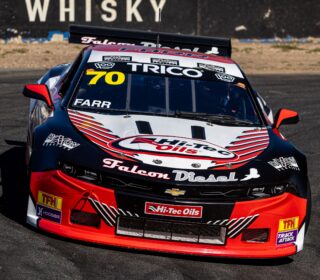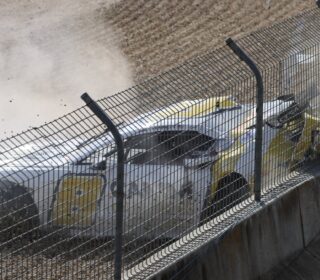THE GREATEST TITLE DECIDER EVER?

ON ITS OWN, the story of how the 2010 Australian F3 championship even got to the point of being decided in the fashion it was would take pages and pages of explaining.
Suffice to say that by the time it got to Sandown at the end of the championship, the battle was between British driver Ben Barker, Kiwi prodigy Mitch Evans – both driving for powerhouse outfit Team BRM – and privateer runner Tom Tweedie.
The trio had battled throughout the season: Evans winning early, Barker surging late with several wins in a row and second-generation driver Tweedie nipping at their heels perennially in his older model car.
By the time they got to Sandown it really was a winner-take-all scenario between Barker and Evans, with Tweedie needing some luck to fall his way.
Even at the finale the dramatics commenced early. A remarkable penultimate race of the year was ultimately called early and declared a non-event after firstly a massive turn one crash for Chinese driver Zhang, and secondly for an even more massive crash for privateer Graeme Holmes, who went backflipping down the back straight.
Had the race counted, the result may have been very different. As it was, the scene was set for a final dash to the line.
Here is the recount of that compelling motor race one that, for those on the day, remains clear in the memory for its burning intensity. Few who witnessed it live can remember a race fought out over 15 more intense laps than this one.
Settle in for a long read, but enjoy the story of what – for those who saw it – remains one of the most compelling championship deciders ever held.
**
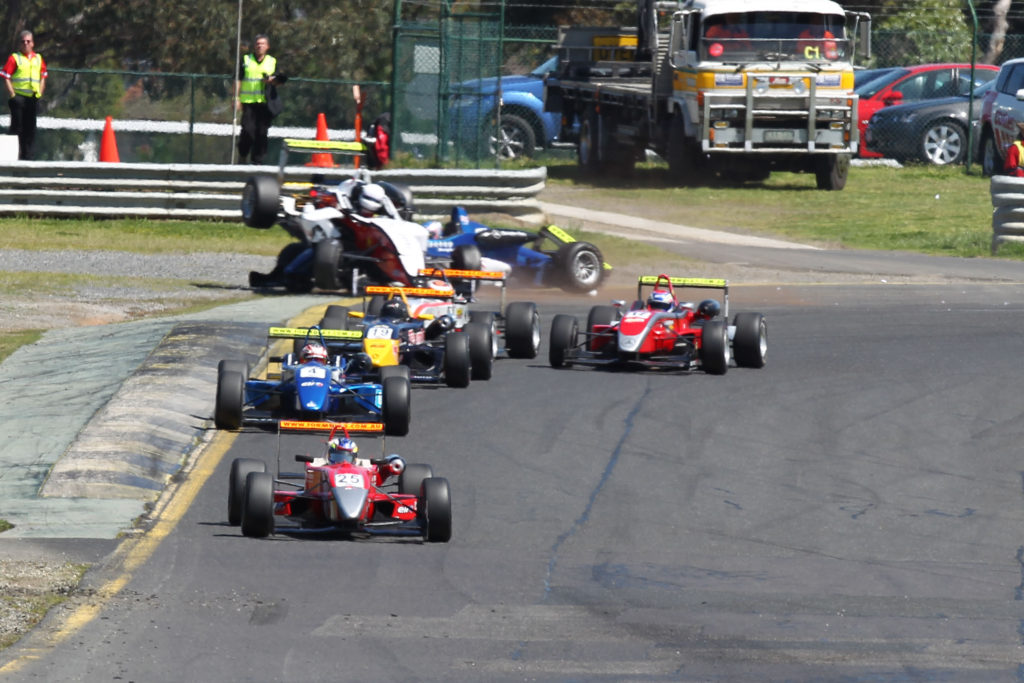
THE TALE of the final showdown of the 2010 Formula 3 Australian Drivers Championship does not begin with the champion, Ben Barker.
It begins with Tim Macrow, the not-so-new winner.
The Tim Macrow that arrived at Sandown was one with no expectation and no responsibility. It was an opportunity to just drive.
A former champion of the series, he was in an old car with an unknown pedigree. He had not started a Formula 3 race for eleven months and had only raced competitively twice in the past twelve.
So, few people knew what kind of role he could play at Sandown. Sure, they knew his seventy-plus starts, 14 wins and one championship win to that point would ensure that he would be reasonably competitive regardless of the machinery – though few could have guessed just how well the weekend would work out for the laconic Melbournian.
If there were any doubters, they were silenced within one lap of first practice on Friday.
The Tim Macrow that presented at Sandown may have questioned his own fitness in his regular self-effacing way, but his driving was as… as spectacular, as fluid and as aggressive as ever.
This was the same Tim Macrow of old, one who exited each corner with the tail wagging, with epic car control and a style of finessing the car with a fifteen-kilogram sledgehammer.
And it was the Tim Macrow who pieced together a drive over fifteen laps that smashed his opposition into the ground with metronomic consistency and staggering sensitivity for tyre performance and the handling balance of his aging Dallara, as well as an acute awareness of the race around him.
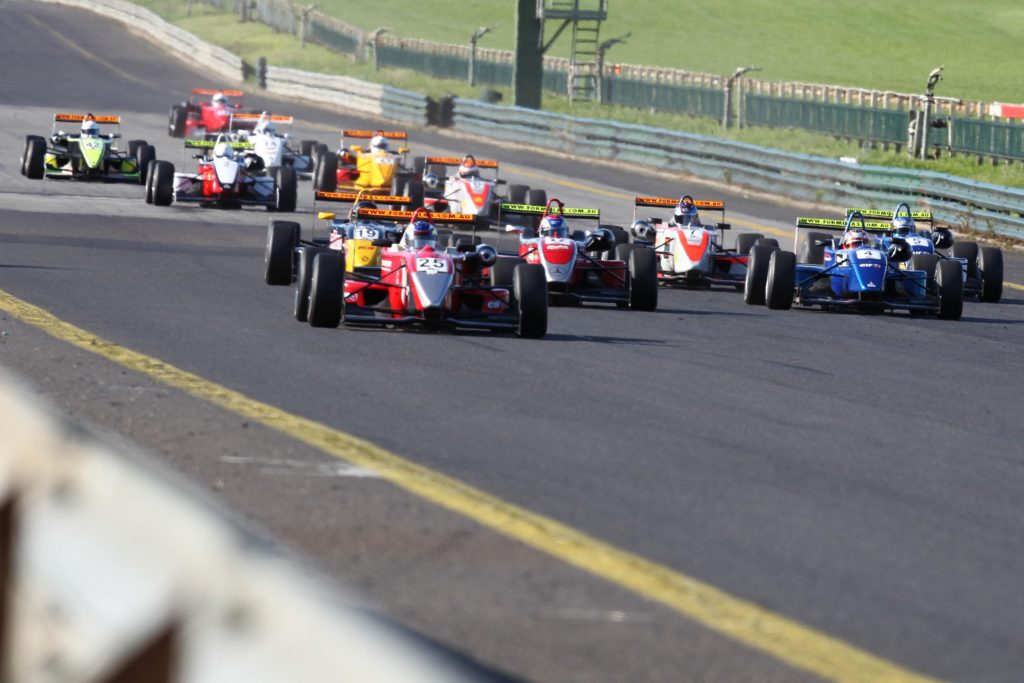
Macrow is a driver who can be jovial, cheerful and chatty with his crew sitting on the grid before turning into, committed, focussed driver with a killer instinct up with the best of them with the flick of an ignition switch and the push of a starter.
From pole, earned by a comfortable lights-to-flag win in race one, car #25 started as well as ever and, after a brief move to cover off any wannabe aggressors into turn one, led the pack through the first corner.
And then he set the cruise control.
Cold tyre pace won Tim the championship in 2007 and this is clearly a trait he had not forgotten:A standing lap of 1m16.7539 was eight tenths faster than Mitch Evans, who had fended off both Tom Tweedie and Ben Barker to hold second through Sandown’s right-left-right-right opening sequence. It was a full one point five quicker than the latter pair who were left to squabble on their own.
So at the end of lap one Macrow had nearly eight-tenths on the 16-year-old New Zealand prodigy Evans, who had a further five tenths on Barker and even more on Tweedie. Thus the battle commenced.
By the end of lap two, two things were clear. The first was that the leader intended on breaking the back of his opponents early. With no desire to involve himself in other people’s title battles, Macrow had stated his intentions well before the meeting: Clear out and let them fight amongst themselves.
Hence the margin of more than one point five seconds at the conclusion of lap two.
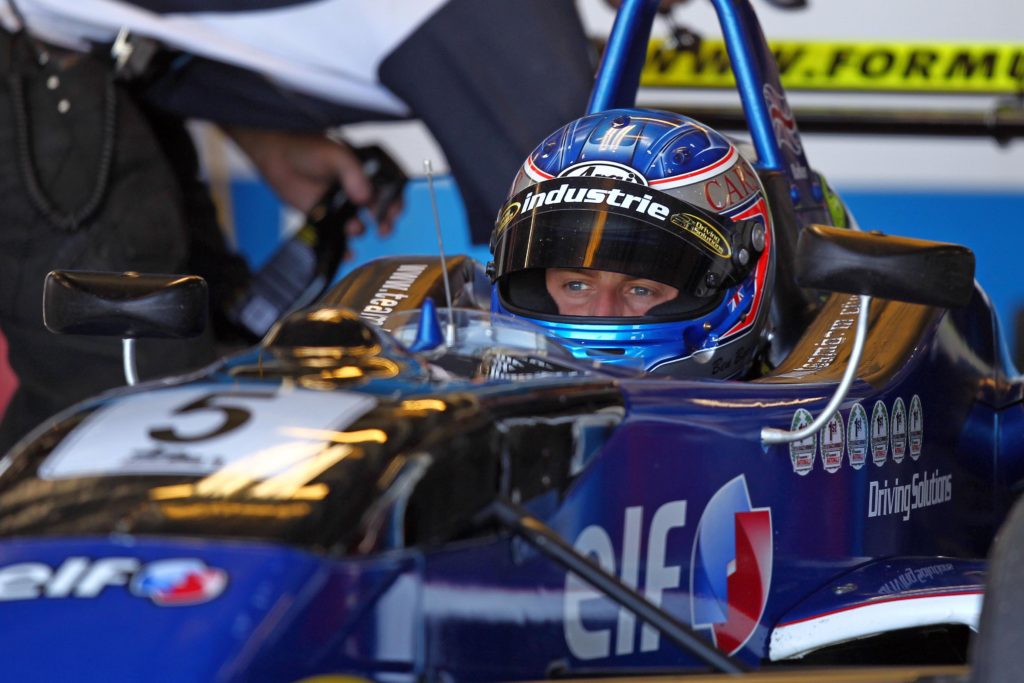
The second was that, at least in the early stages of the race, Ben Barker had a very quick racing car but didn’t really need to use it.
With nearly double points up for grabs, the bottom step of the podium would win Barker – at the time an 18-year-old Englishman with barely a full season of car racing under his belt prior to emerging in Australia – the championship, even with Evans finishing second.
As the pair crossed the line at the end of the second lap Barker would have held a two-point margin over Evans in the final standings – even if his young Kiwi garage-mate set the fastest lap and scored the one bonus point that went with it.
But if Evans got to Macrow and passed him, things would be different. So, third place, right on the tail of the nearly identical No. 4 car would do nicely, thank you, at that moment in time.
Things stewed quietly as the trio completed lap three, Evans going two-tenths quicker than Macrow – a 10.47 to a 10.77 – to set the fastest lap but Barker, too went faster than the leader and Tweedie had also begun to find pace as his less draggy, slipperier 2004-sprc Dallara took more time to get its Kumho’s up to proper, optimum temperature when compared to the aero-ridden ’07 cars.
With intent and purpose Macrow re-set the benchmark to an impressive 1:10.0177 the following lap and began to build a buffer he would never lose.
In fact, the 27-year-old was driving better now than many had ever seen him before.
Clearly comfortable and obviously delighting in the balance and speed of a well set up racing car, Macrow’s next eight laps weren’t just the epitome of consistency – no, they were staggering.
The numbers read like they had been programmed by a computer. Lap five was a 1:10.0830, 0.08 slower than his last. Then a 10.0836, 10.1711, 10.0255 and a 10.0714. By the tenth lap, when he drifted back into the relatively pedestrian 1m10.2s bracket the leader was out in front by three seconds and counting. The race was just about done.
Behind him though, by lap five things had now began to concertina up behind him with each of the following three cars lapping quicker than the next as they closed to within one second of each other in an engaging three car fight to decide second in the race but first in the championship.
And then the game changed again: Now pressures had normalised and drivers became settled it was Evans who began to struggle. It was clear that Barker had the quicker car, even though they were lapping within a few hundredths of each other, if according to the timing monitor.
On the fifth and sixth laps Barker began to toy with the rear end of the Dallara he was following: experimenting with the tow down the 245km/hr back straight, showing a nose up the inside of Dandenong Road, the tricky right-hander that presented the best overtaking opportunity on the track if you were in a Formula Three open wheeler.
And then at the end of the seventh lap one of the more dramatic moments of the season took place.
To that point, the Aussie underdog Tom Tweedie had been happy to consolidate his fourth place whilst the two blue cars ahead of him diced, mere millimetres apart. However, when Evans aggressively defended a move attempted by Barker, the young Sydney star was in a position to capitalise.
Barker tucked into the tow of Evan’s identical Dallara on lap seven, getting that vital few kilometres per hour boost as the two cars, now locked together, ran to the top of the hill and began the rollercoaster ride towards the left hander at Dandenong Road.
Barker’s run was impressive but Evans was equal to the task. He sat his Dallara right in the middle of the road into the corner, through the corner and out of the corner. And that’s where he stayed.
Through the right hander just prior to the grid Evans defended hard. Barker went left, then right, unable to find a way through.
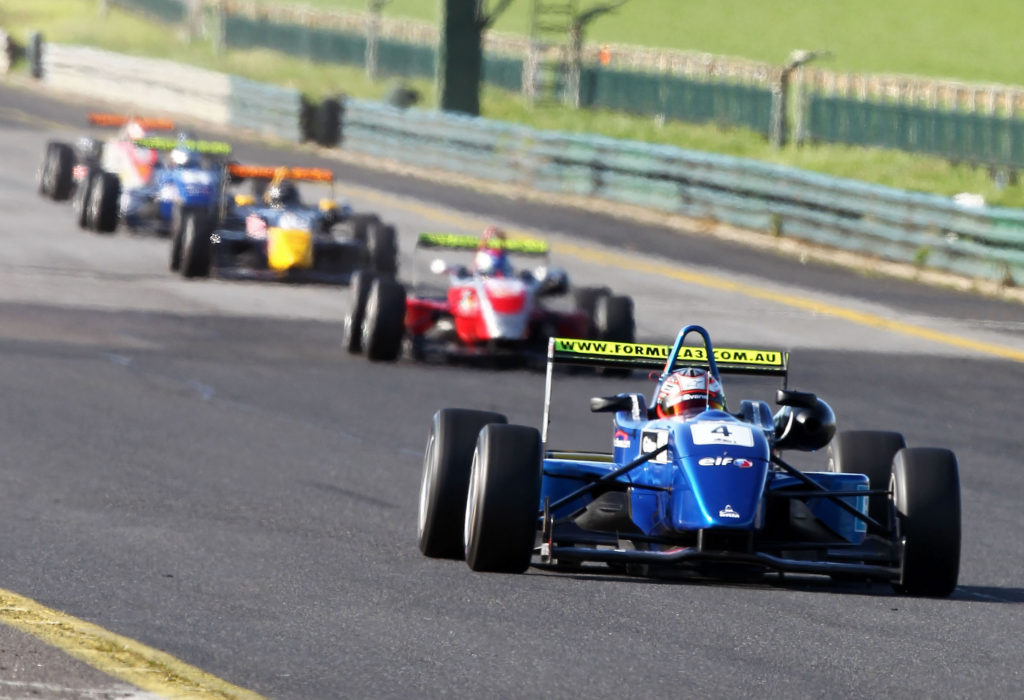
On the run onto the straight it was now clear the Brit was in massive trouble. His attacking – or Evans’ defending, whichever way you look at it – had cost him corner exit speed and now Tom Tweedie was there to pass.
It is hard to know what Ben Barker may have thought when he saw the little Blue and Yellow Dallara, all pretty in its Red Bull-lookalike livery, slice past him on the outside before even reaching turn one at the beginning of lap eight. That he did, however, and all of a sudden every calculator between Sandown Pit garages one and fourteen were taken out and worked overtime because the scenario had changed.
With Evans holding second, fourth place for Barker would leave the two BRM cars tied on points, a scenario that would not be in favour to the lanky brit: Evans’ eight wins throughout 2010 would have handed him the trophy on a countback.
To the point, twenty-one races into the season, Barker had won only six times.
It wouldn’t be enough.
Remarkably, it was Tweedie who struck Barker another blow on lap ten when he was the first driver to drop into the 1m09s, his 1m09.7268 now the fastest lap of the race and critical because that, too, awarded a bonus point.
Remember that, for it will become apparent later just how critical that fastest lap point would be.
For Barker, it was if the world was ganging up on him – now even a driver from another team was helping Evans win the title.
Though nowhere early, Tweedie had now come alive. By now it was clear that any title hopes the second-generation driver had left from a championship perspective were slipping away but, like a true Australian underdog should, this driver was not going to go down without a fight.
With less downforce than those around him, Tweedie’s Dallara was dancing through the esses, down through the gears and under brakes into Dandenong as he did everything to extract a lap.
‘Who knows,’ he thought. ‘Pressure can do a lot to drivers’.
Perhaps, he thought, it could unseat the previously unflappable Evans? Perhaps, just perhaps, the little Aussie battler could still inflict a stinging blow to his Kiwi rival before this year had ended.
By lap eleven the three contenders, still nose to tail, were all in the high 1m09s and the game had lifted.
It lifted further on the next lap, when the three title contenders – Macrow clearly in their sights as a benchmark for braking points and turn in references – lapped within five one-hundredths of each other.
And then it was cranked up to eleven.
Whilst this game for second was going on, Macrow’s several-second buffer had been steadily maintained, if not exactly expanded. But on the eleventh and twelfth laps his times drifted ever so slightly and the chasing triumvirate closed in on the red, white and silver 25 car. That would not do for the former champion, keen to remind people of his capabilities against these young upstarts emerging on his turf.
But it wasn’t a worry. Using his advantage to give his rubber a respite, Macrow had a revitalised car under him and decided that It was time for the champion to respond. And oh, how he did.
As the leading cars crossed the line to complete lap thirteen these are the times they set.
Tim Macrow, the leader: 1:09.8789.
Evans, now less than a second behind: 1:09.8543.
Tweedie, searching for an elusive tow: 1:09.8743.
And finally Barker, holding on, waiting, watching: 1:09.8537.
At the time it seemed scarcely believable. Four drivers from three countries, in two different models of cars built by three teams from three states and by a diverse group of about twenty people and on lap thirteen they lapped Sandown’s 3.1 kilometres of twelve turns, rises, falls and bumps within 0.0252 of a second.
There were times during the year, sometimes rightfully so, where people accused Australia’s top Open Wheel formula of not being competitive or enjoying relative depth. This was not, it has to be said, one of those times.
This was one of those special moments where four drivers at the very pinnacle of what is capable of behind the wheel of a pure-bread racing car were doing what they did best.
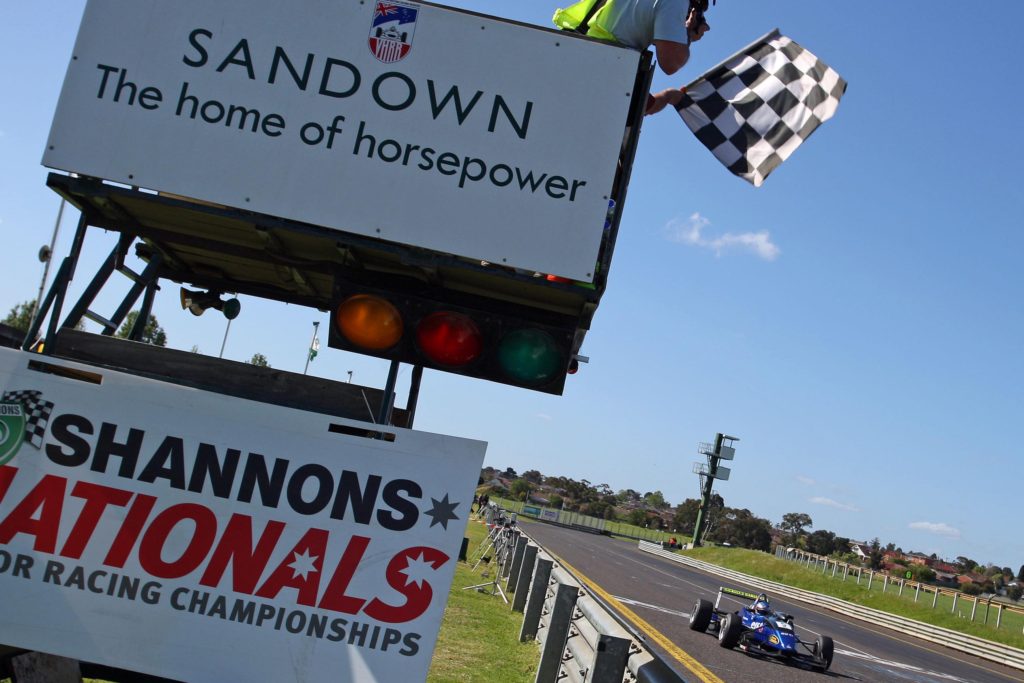
Macrow upped the ante again on lap fourteen, pounding in a 1m09.7893 to firmly reassert his position in front. Evans’ was a touch slower but he now had a three car length buffer to Tweedie, in third. It might not sound like much, but in a race where margins were split by microns then it may have been enough.
Tweedie, next and inspired, almost matched his then-fastest race lap with a 09.7833 and it looked good, but the bigger news was that lap fourteen was the lap where Ben Barker re-joined the party.
Two laps earlier, Team BRM engineer Craig Rundle – in touch with both his drivers and playing as fair a game as anyone could in such a position – had given the driver in car #5 the news.
At this rate Evans would be champion. Push on, son, or lose.
The multiple-time championship winning outfit from Adelaide were now almost assured another title, and it was up to either driver to decide which side of the garage would celebrate the most.
With perhaps the slightest tow from Tweedie ahead, and with as much commitment his nineteen-year old brain could muster, Barker hit every mark, every apex and every throttle application on lap fourteen.
The result was the race’s fastest lap: 1:09.6563. A time Barker will never forget.
Mitch Evans, however, had not quite finished yet. Whether he knew at that stage whether Barker had fastest lap or not we may never know, though it’s safe to assume he did. Regardless, the young Kiwi went for it on the last of 15 laps.
The next time around, Macrow crossed the line to get the flag. His last lap was a second slower than his last: The champ had given his all and proved again why he is so highly rated amongst his peers. This was a drive up there in commitment and concentration with the one that won him the title three years earlier. It was masterful.
The next two point five seconds decided the championship.
If Evans’ – or even Tweedie – set the race’s fastest lap on the final tour, the title would go to the New Zealander.
But, if Barker’s time from the lap before stood or if he improved, he would be king.
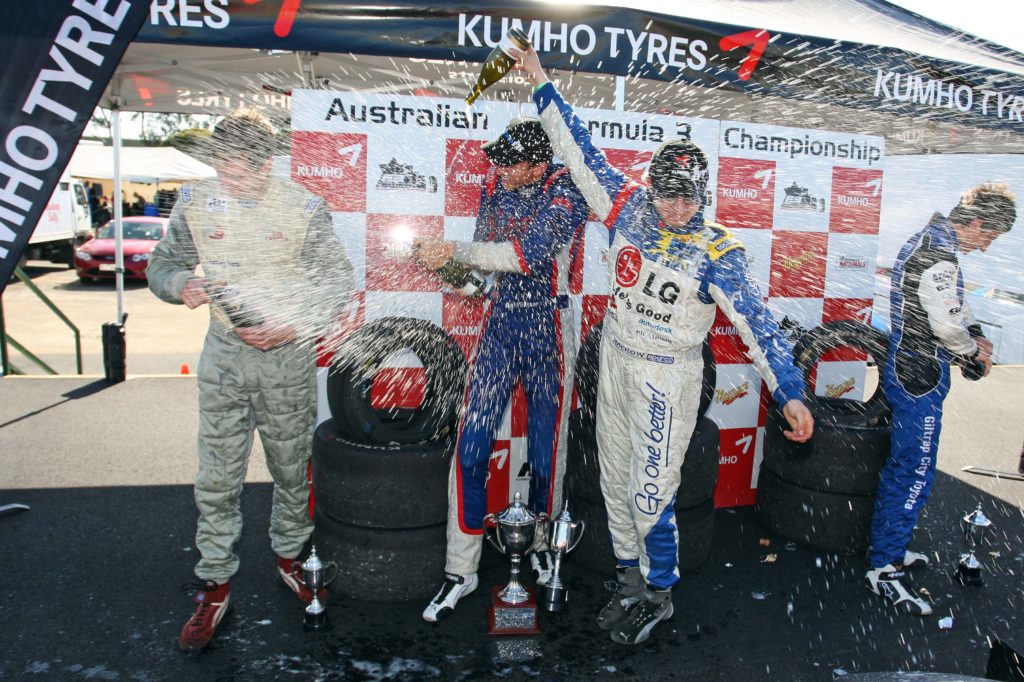
There has been tension in motorsport before and there will be in days to follow, but the feeling that permeated from the Team BRM camp on that final lap was felt all around Sandown on that one glorious Sunday afternoon in spring.
It was choking, suffering tension of a group of people accustomed to winning right on the edge.
After all, these two were fighting for the biggest sheep station of them all in the context of their careers, at that point.
Mitch Evans crossed the line having given his all, but a brief moment of oversteer exiting the final corner, the smallest of errors, ensured it was game over. His lap was a 1m09.7065. With Tweedie lapping slower again, Ben Barker had just won the championship by setting the fastest lap of the most important race of his life.
The official margin was one point.
The real margin? 0.0502s.
In this sport of incredible machines, of astounding feats and of heroes to many, it just does not get any closer.
POSTSCRIPT:
Mitch Evans would move to Europe following this season, winning races in GP3 and GP2 and coming close to Formula One before joining Jaguar as a factory driver in the FIA Formula E Championship.
Ben Barker moved to Carrera Cup with BRM the following year before heading back to Europe in 2012. Since then he’s become a Porsche Professional and currently races for the Gulf team in the FIA World Endurance Championship.
Tom Tweedie raced in the Super2 series, smashed records in his old man’s F5000 and historic sports cars and still races in historic competition.
Tim Macrow won another two championship titles in Australian Formula 3 and now races in the FRD LMP3 Championship in China, and is the test and development driver for S5000 Australia – amongst other things.
WORDS: Richard Craill
IMAGES: Nathan Wong / TheRaceTorque.com Archive



